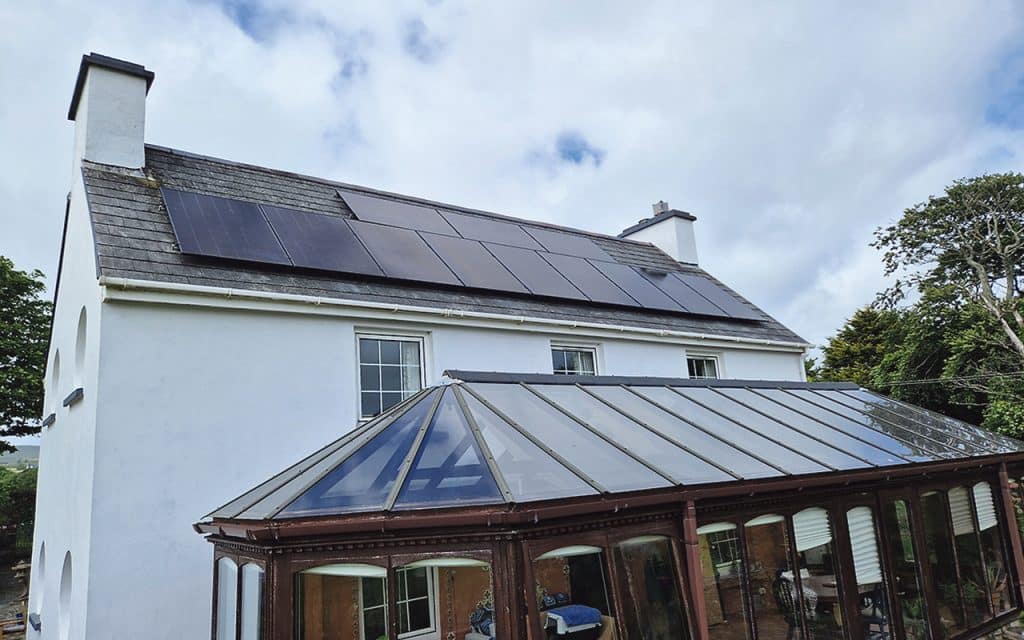The installation of solar panels on roofs around West Cork has become more popular in the last few years. It is a regular upgrade that my clients consider; either as a stand-alone job or as part of a larger retrofit. Back in June, we decided to go ahead and fit solar panels on our own house. The first thing that I must be honest about, is that I went against the advice I would give a lot of my clients, which is; first to insulate your house properly, then to upgrade to an efficient heating system and finally to fit renewable technologies, like solar PV to generate your own electricity. Instead, we have only done about 50 per cent of the insulation so far, (it’s a big house!) and upgraded most of the heating system. Our family grew at the end of last year with the birth of our son; this changes things a little. Completing further messy and disruptive insulation work isn’t really viable right now. This year’s project was instead to install solar PV which is a relatively simple, clean and a fast job to complete.

The term ‘solar panels’ is often used interchangeably to describe solar thermal panels that produce hot water and solar PV (photovoltaics) that produce electricity. These days most of the installations are solar PV, which is the focus of this article.
So how does it work? Without getting too technical, a solar panel is made up of a number of solar cells, usually made from silicon wafer. When light falls on the solar cells, electrons are knocked loose from the atoms creating a flow of electric current. One of the beauties of the technology is that there are no moving parts and, hence, no maintenance is really required.
We have a fairly typical system of 12 solar panels, an invertor necessary on all installations to convert the electricity to a useable form and a solar divertor that sends excess electricity to the immersion in our hot water tanks. This means we get free hot water when we have excess solar electricity, which is one of the reasons for the drop in popularity of solar thermal panels. These diverters can also be used to send the excess electricity to charge an electric car. We didn’t go for batteries, partly due to the cost, as they add about 30 per cent to the install cost and also, with the new clean export tariff, you can sell your excess electricity back to the grid, with current rates averaging about 21c a unit. Battery technology is however improving all the time, and life expectancy, one of the main issues with batteries, is getting better. There are also other advantages, using them to store cheap night rate electricity from the grid for use during the day, for example. We may fit some in the future and went for a hybrid invertor, (battery ready) to make this as straight forward as possible when the time comes. I also recently came across a novel idea to take old electric car batteries and fit them in people’s homes. There is in fact an Irish startup offering this service.
Our panels are fitted on the South facing side of the roof but also work well on East or West facing roofs. In fact, a combination of East and West facing panels works well to catch morning and evening sun. They can also be ground-mounted on a frame if you have an unshaded space that is big enough in your garden. The output of the panels is measured in kilowatt peak, (kWp). Panels, these days are around 435 Wp and measure roughly 1100mm x 1800mm. Our 12 panels give a total of 5.22 kWp. This should generate about 4,500 units of electricity (kWhrs) per year. Roughly 75 per cent of this would be between May and September. The average household electricity use in Ireland is 4,200 units per year. We have a heat pump so use more than this. In theory, you could cover the electricity use of a typical house with a system of this size. The reality is that there will always be a mismatch between the supply of solar electricity and your demand. During the summer months, you will generate more than you need and in the winter less and, of course, the panels don’t generate electricity at night!
In terms of investment costs, a system like ours should cost somewhere between €7,000 and €10,000 and there is no VAT to be added since 2023. The Sustainable Energy Authority of Ireland, (SEAI) offers a maximum grant of €2,100 for a system of 4 kWp and less for smaller systems. Savings on your electricity bills could be in the region of €1,000 plus per year. So after grants, the payback is between five and eight years, which is quite attractive – most panels have a 25 year warranty. We have only had our system running for three months but it has already given us a benefit of almost €500 between savings and export. You can also see in the below graph the total generation across these months of 1,840 kWhrs, roughly half of which we used and the rest we sold to the grid. We would expect to use a higher proportion of the electricity generated, as we move into the Autumn months where generation will be lower.
If you are considering solar yourself, the first step is to get a quote from an SEAI registered contractor/(s). Then, you complete a simple application online via the SEAI website where the approval is instant and you will have eight months to get the work completed. Once the installation is done, you pay the contractor, have a post work BER completed and then claim the grant back from SEAI, which takes about six weeks to come through. Be aware, the SEAI grant is due to be reduced by €300 per year over the next seven years until it goes completely, so get your applications in before the end of the year!



